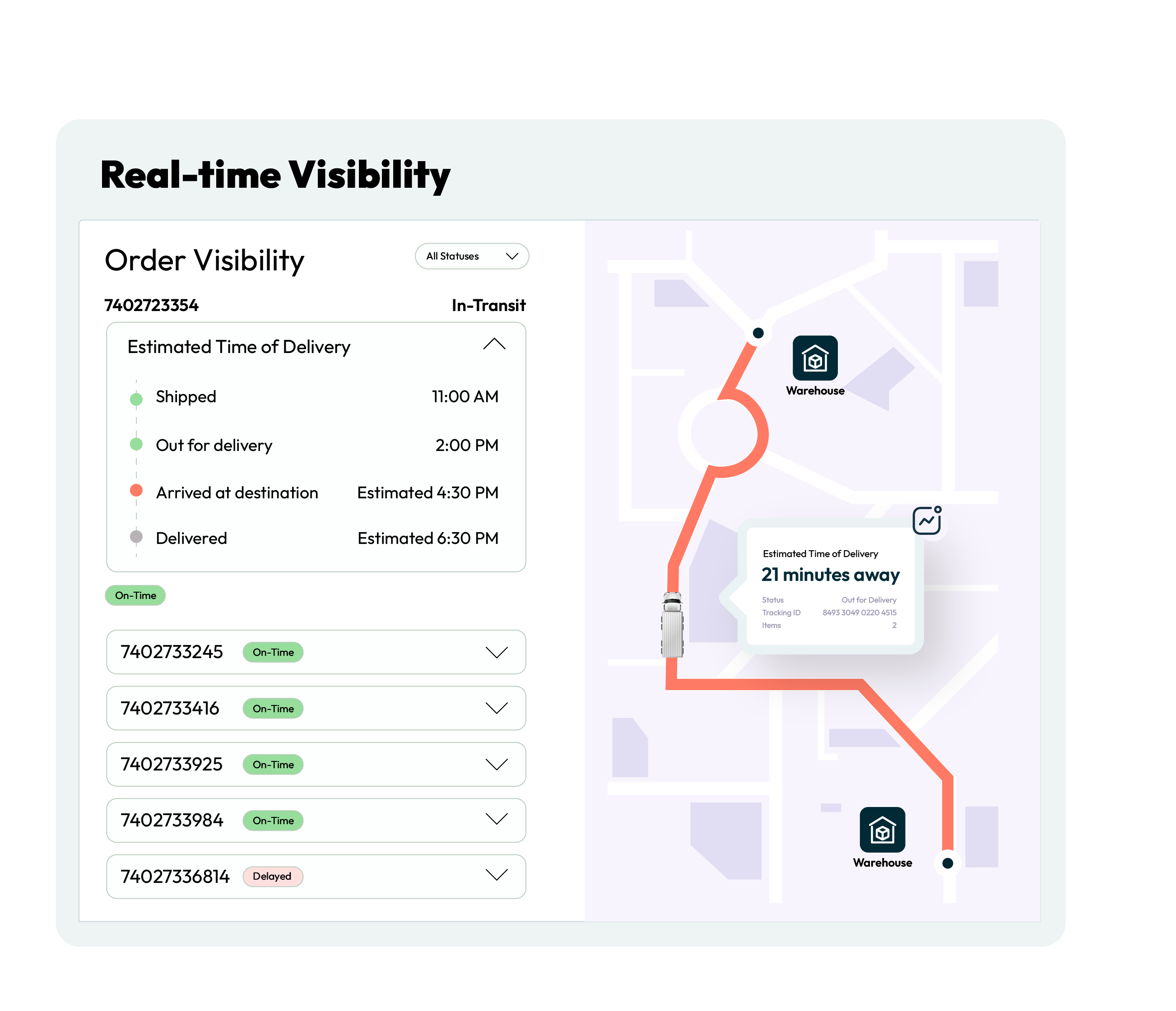- Route
Route Planning Software for Large Fleets: Solving Common Operational Challenges
Table of Contents

Keeping a large delivery fleet running smoothly is never simple. Parcel volumes in the United States are expected to reach new records, with over 26.8 billion shipments forecast for 2027. With every new surge, logistics teams feel the weight of tighter delivery windows, cost pressures, and growing customer expectations. Getting route planning right makes the difference between leading the market space and falling behind.
Many supply chain managers and dispatchers know this pressure all too well. There’s no room for guesswork. Vehicles, drivers, and every mile on the road must be counted and optimized. Old habits, manual scheduling, spreadsheet planning, and basic GPS apps aren’t enough anymore.
Leading fleets use modern route planning software to turn operational headaches into competitive advantages. The right solution blends real-time data, advanced algorithms, and a focus on results, not just routes.

What is Route Planning Software?
Route planning software is a digital solution that automates and optimizes how you allocate deliveries, assign vehicles, and sequence routes. These platforms combine real-time data, advanced algorithms, and fleet management features to turn complex logistics into actionable, optimized routes.
Modern software for route planning ingests data from your OMS or TMS, processes it with AI, and outputs live, efficient route plans. You get less wasted mileage, higher driver productivity, and fewer missed deliveries.
The Complexity of Modern Fleet Operations
Why does planning become so tricky as fleets grow? Larger fleets have to manage a tangled web of orders, vehicles, and customer needs. You may have a mix of delivery vans, trucks, and gig drivers. Each comes with its own constraints, capacity, compliance rules, and even unique delivery skills. Add fluctuating order volumes and unpredictable city traffic, and simple planning turns into a daily puzzle.
Today, even a slight mistake in assigning orders or missing a delivery window can hit margins hard. Regulators watch closely, too. Hours-of-service rules, environmental restrictions, and new sustainability targets all add layers of complexity. And let’s not forget about customer service; missed ETAs or unclear updates can cost repeat business.
Why Old Methods Don’t Hold Up
Not long ago, planners would lean on local know-how and years of experience. Hand-drawn maps and a strong memory were enough for small operations. But scale exposes the cracks. Picture a fleet with a hundred vehicles and thousands of orders each week. The sheer number of route combinations makes manual planning almost impossible. A single oversight might mean wasted fuel, overworked drivers, or late deliveries.
Plus, real-time issues, road closures, weather, and sudden order changes are the new normal. Legacy methods simply can’t adapt quickly. Fragmented systems, like disconnected spreadsheets and GPS trackers, make it hard to see the whole picture or react on time. The gap between best-in-class and the rest is only getting wider.
Core Capabilities of Modern Route Planning Software
When the old ways fall short, what actually works? Today’s route planning software is designed to handle complexity without slowing you down. It doesn’t just draw a line from point A to B. Instead, it pulls in live data, applies business rules, and considers hundreds of constraints with every plan.
Modern routing planning solutions stand out because they:
- Ingest Real-time Data with Ease
No dispatcher can watch every road or react instantly to every event. Software built for dynamic routing solves this. It monitors live traffic, adjusts for road closures, and reacts to sudden spikes in orders. Everything updates automatically, which means less stress for planners and fewer surprises for customers. - Factor in All the Details That Matter
Large fleets can’t afford to overlook anything. The best routing planning software lets you consider dozens of variables: vehicle size, driver schedules, weight limits, loading times, service windows, special delivery optimization needs, and more. FarEye even works with EV charging needs and compliance constraints, making sure your plans don’t just look good on paper but work in real life. - Automate the Tedious, Let People Focus on What Counts
When software handles planning, it frees up staff to solve bigger problems or support drivers in the field. With FarEye, you can plan thousands of orders in a fraction of the time it used to take. Planners can shift focus to resolving exceptions, building customer relationships, or improving operations overall. - Keep Everyone Informed
Transparency matters; drivers, dispatchers, and customers all expect to know what’s happening. FarEye’s fleet management platform includes real-time dashboards, driver mobile apps, and customer notifications. This means better service, fewer calls about ETAs, and a lot less time chasing down answers.
Addressing Operational Pain Points Head On
Anyone who’s managed a large fleet knows the most common problems:
- High Delivery Costs
Fuel, labor, and vehicle maintenance add up fast. FarEye AI-powered routing helps squeeze more value from every mile. By reducing empty miles, clustering deliveries, and planning smarter, some fleets have cut operational costs by up to 20%. - Capacity and Shift Utilization
Having drivers or vehicles sit idle is expensive. Good software balances workloads and plans around driver hours and makes sure you’re never paying for wasted time. FarEye enables planners to adjust on the fly, improving capacity utilization and helping staff make the most of every shift. - Inefficiency and Lost Time
Address errors, lost drivers, and poor sequencing can ruin a delivery day. Automated address validation and live rerouting ensure drivers spend more time delivering and less time searching. More accurate routes also mean fewer delays and higher on-time rates. - Backhaul and Empty Runs
Nobody wants trucks running empty. With intelligent planning, FarEye’s system spots backhaul opportunities and plans return loads automatically. Every trip counts, reducing waste and improving revenue per mile. - Adapting to the Unexpected
Traffic jams and last-minute changes are part of the business. FarEye’s engine adjusts instantly, keeping ETAs accurate and everyone informed. The system’s ability to adapt in real-time is what sets leaders apart from the rest. - Meeting Sustainability Goals
Sustainability is more than a buzzword. FarEye’s software for route planning supports green delivery windows, suggests low-emission slots, and helps fleets cut both costs and carbon output. This enables companies to meet regulatory targets while appealing to eco-conscious customers.
AI and Machine Learning: Where FarEye Excels
There’s a big difference between “smart” software and truly intelligent dynamic routing. FarEye’s AI-based fleet management platform learns from every delivery. Its SMART Service Times feature predicts how long stops take in each area, using real data, not just guesses. Over time, the system gets better, learning patterns and making sharper recommendations.
Another FarEye advantage is rate-based dynamic routing. The platform mixes private fleets and gig drivers, weighing cost, timing, and customer promises in every decision. Planners can blend in-house and external resources to meet peaks without breaking the bank.
Proof in Performance
The best test for any software is what it achieves in the field. One express logistics leader in Southeast Asia turned to FarEye to tackle growth pains and rising costs. The results speak for themselves:
- They cut the number of vehicles needed by 60%.
- The team of planners and dispatchers shrank by 70%.
- They managed to reduce their driver pool by 40% without losing service speed or quality.
- The time needed to assign bookings dropped by 66%.
These aren’t small improvements. They reshaped the company’s cost structure, let them scale without adding overhead, and gave customers faster, more reliable service. FarEye’s technology lets their teams focus on growing the business, not just fighting fires.
The Strategic Imperative for Enterprise Fleets
With so much at stake, costs, compliance, and reputation, there’s never been more pressure to get routing right. Old methods can’t keep up. The right route planning software turns chaos into control and uncertainty into opportunity.
FarEye leads the field, offering American enterprises a future-proof fleet management platform for scaling up, responding to market shifts, and delivering better service. Whether you’re running regional routes or national networks, you need software for route planning that’s as agile and ambitious as your business.
Ready to put your fleet in the lead? Discover how FarEye’s AI-powered route planning software can help your business solve its biggest operational challenges and turn every delivery into a strategic win.
FAQs
How quickly can I implement route planning software?
Most large fleets can go live in 30–60 days, depending on integrations and training needs.
Will routing planning software work with my existing TMS or OMS?
Yes. FarEye’s fleet management platform offers robust API integrations for seamless connections to your current platforms.
Does this support EV fleets and green initiatives?
Absolutely. FarEye’s system accounts for charging needs and offers green delivery slot optimization.
Source:

Komal Puri is a seasoned professional in the logistics and supply chain industry. As the AVP of Marketing and a subject matter expert at FarEye, she has been instrumental in shaping the industry narrative for the past decade. Her expertise and insights have earned her numerous awards and recognition. Komal’s writings reflect her deep understanding of the industry, offering valuable insights and thought leadership.
Let's Talk to Our Experts and Optimize Your Deliveries Today!
An expert from our team will reach out within 24 hours


